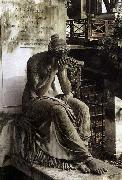La Peinture à l'huile en gros de Chine & Encadre |
|||||||||||

|
|||||||||||
|
|
|
||||||||||||||
|
|
||||||||||||||
|
||||||||||||||
|
|
||||||||||||||
| unknow artist
Sorrow 1816 Marble, height 135 cm P?re-Lachaise Cemetery, Paris The P?re-Lachaise Cemetery in Paris, opened in 1804, was soon covered with monuments and these, together with the beauty of the site and the many plants and shrubs surrounding the tombs, made it during the romantic period a popular resort on half-days and holidays. Under the Ancien R?gime, people sought to ensure their salvation by endowing foundations; in the nineteenth century, their successors were anxious above all that their memory should not die, oblivion being in their eyes ultimate death. The decree law of 1804, followed by the creation of the big cemeteries outside the city walls, was an expression of this new materialistic form of respect for the dead and guaranteed the success of the sale of burial plots in perpetuity and monuments designed to preserve - and extol - the memory of the deceased. In keeping with this trend, images depicting Death were seldom placed in cemeteries. On the other hand, the representation of Grief, am indirect way of paying tribute to the dead, is a favourite theme very much in evidence in funerary sculpture, expressed sometimes in allegorical, sometimes in narrative form. As early as 1816 Milhomme created a fine figure expressing the sorrow of the widow and six children of Pierre Gareau, killed in an accident. The Milhomme figure begot many more of the same kind, but the scenes of affliction came to an end with the years 1820-25. Author: MILHOMME, Fran?ois-Dominique-Aim? Title: Sorrow, Tomb of Pierre Gareau Form: sculpture , 1801-1850 , French , religious 1816 Marble, height 135 cm P?re-Lachaise Cemetery, Paris The P?re-Lachaise Cemetery in Paris, opened in 1804, was soon covered with monuments and these, together with the beauty of the site and the many plants and shrubs surrounding the tombs, made it during the romantic period a popular resort on half-days and holidays. Under the Ancien R?gime, people sought to ensure their salvation by endowing foundations; in the nineteenth century, their successors were anxious above all that their memory should not die, oblivion being in their eyes ultimate death. The decree law of 1804, followed by the creation of the big cemeteries outside the city walls, was an expression of this new materialistic form of respect for the dead and guaranteed the success of the sale of burial plots in perpetuity and monuments designed to preserve - and extol - the memory of the deceased. In keeping with this trend, images depicting Death were seldom placed in cemeteries. On the other hand, the representation of Grief, am indirect way of paying tribute to the dead, is a favourite theme very much in evidence in funerary sculpture, expressed sometimes in allegorical, sometimes in narrative form. As early as 1816 Milhomme created a fine figure expressing the sorrow of the widow and six children of Pierre Gareau, killed in an accident. The Milhomme figure begot many more of the same kind, but the scenes of affliction came to an end with the years 1820-25. Author: MILHOMME, Fran?ois-Dominique-Aim? Title: Sorrow, Tomb of Pierre Gareau Form: sculpture , 1801-1850 , French , religious |
||||||||||||||
|
Related Paintings to unknow artist :. |
||||||||||||||
|
|
||||||||||||||
|
|
||||||||||||||
|
CONTACTER DES Etats-Unis |







